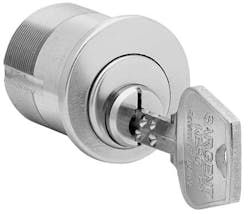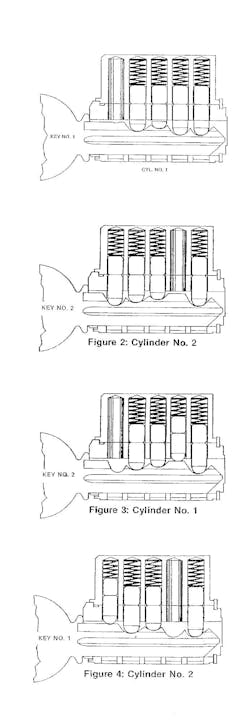Master keying is a fundamental locksmithing task.
According to Locksmith Ledger’s 2022 State of the Industry survey, more locksmiths perform master keying as a service than anything else (other than key generation, of course). Nearly 88% of locksmith businesses perform master keying, according to the survey.
But what about positional master keying?
“Positional Master Keying tends to be an elusive entity or, as some may say, ‘an odd duck’ to many locksmiths,” says William M. Lynk in the opening sentence of his latest book, “Positional Master Keying Unveiled.” The book should be available by the time you read this at Lynk’s website, www.iclsglobal.com, as well as through several resellers, including ALOA.
Lynk, a longtime locksmith who is an interchangeable-core specialist as well as a certified instructor, says the book fills a niche in the master-keying world.
“I realized years ago there was no book really thoroughly explaining what positional master keying is,” he says. “To most locksmiths, it’s a strange kind of a duck, as I call it, because it doesn't follow the same rules as traditional split-pin master keying.
“I teach locksmiths throughout the country, and the topic comes up, and most of them have no clue what it is even though they may run into it in certain institutions.”
Position to Learn
So what’s positional master keying? Lynk, who was named chairman in 2021, cites the Lock Industry Standards & Training (LIST) Council’s definition in his book:
In other words, positional master keying is used in key systems that rely on the positioning of empty, or “inactive,” chambers in the lock cylinder. (“Active” chambers contain springs and pins.)
Typical master-key systems are based on the locations of master pins to form the shear line for master keys and change keys (and grandmaster keys, etc.). They involve a key bitting array and progressions as well as some math, which explains why master keying has moved to the computer, spreadsheets and master-keying software. Positional master-keying systems don’t even include master pins.
This fundamental difference between the two systems is what makes positional master keying “bewildering” to the average locksmith, Lynk says.
“They have trouble understanding how you can rotate chambers, filled and empty chambers,” he explains. “That kind of throws them, because they’re used to locks that have something in every chamber.”
Lynk adds two other facets that might throw off locksmiths:
- The ability to master key a lock that has no master pins.
- The perception that the inclusion of empty chambers would cut down the master-key system dramatically.
“In positional master keying, you are rotating anywhere from, minimum, possibly 12 to 31 different chambers or positions,” Lynk says. “Most locks that use split-pin have six or seven chambers, and if you took one of those and rotated it as an empty chamber, you'd be losing a sixth or a seventh of your system bittings, so it’s not practical to do it. Also, the other chambers are using master pins.”
So how do you master key a cylinder that has blank chambers so only certain keys will turn the cylinder? The specific answer depends on the system, but, in general, you do so by making sure the key has a shallow cut at the position that lines up with the empty chamber, or chambers in a more advanced system.
Get in Position
In the book, Lynk provides a chapter on each of the positional master-key keyways, getting into the nitty gritty of how each works and how to build or, more likely because most of the systems are out of production, maintain a master-key system that uses them. Each system does things a little bit differently, so what might work for one won’t necessarily work for the other even though the same general concepts apply.
The keyways are SARGENT Keso, KABA Gemini, Miwa EC, Schlage CorKey, as well as Schlage wafer locks, which Lynk uses as an accessible way to explain the fundamental concepts behind positional master keying. Of those four, only SARGENT Keso remains in production. KABA Gemini has evolved to dormakaba Gemini Plus, which is available mostly in Europe. As for Miwa EC and Schlage CorKey, which use magnets instead of pins, they haven’t been sold in decades.
Lynk acknowledges that the world of positional master keying is small, saying “90% of everything out there is using split-pin.” Of course, that also means that at least some of the remaining 10% require positional master keying, and Lynk says institutional locksmiths in particular might come across a keyway that requires positional master keying.
“They would be found in some higher security areas in a college, a university, a government facility, hospitals — that type of thing,” he says. “That’s why I said, ‘well, let’s get this all together so that someone running into these kinds of systems can start understanding what it is.’”
Positioning the Book
The book itself begins with defining positional master keying and the terms necessary to understand the concept in detail. Next is a “review” of traditional split-pin master keying before delving into each individual system. Each chapter is filled with detailed images and diagrams that explain steps and procedures on how each system works and how a master-key array would be constructed. A “bonus” section on 3-D master keying is included. Finally, a 60-question test gauges the reader’s understanding of the subject.
An appendix includes manufacturers’ spec sheets, diagrams used in Lynk’s courses and other reference materials before finishing with the complete (as of August 2022) copy of “The Professional Locksmith Dictionary” from the LIST Council.
Lynk says he worked on the book for about a decade with assistance from manufacturers to make sure the information presented was technically accurate. In addition to wanting to help other locksmiths, Lynk admits to a fascination with the topic that all began with the definition of positional master keying.
“Having read that many years ago, [positional master keying] just kind of struck me as very, very different, and I wanted to understand more about it,” he explains. “Having studied it more and written on it more, [I decided] ‘let’s put all this together so locksmiths can have it in one unified book that they can refer to for all of their questions on it.’ That was my goal.”
For more information, go to www.iclsglobal.com.







